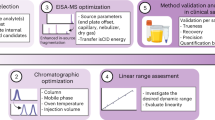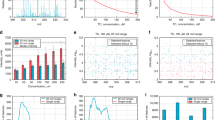Abstract
The revival of interest in cancer cell metabolism in recent years has prompted the need for quantitative analytical platforms for studying metabolites from in vivo sources. We implemented a quantitative polar metabolomics profiling platform using selected reaction monitoring with a 5500 QTRAP hybrid triple quadrupole mass spectrometer that covers all major metabolic pathways. The platform uses hydrophilic interaction liquid chromatography with positive/negative ion switching to analyze 258 metabolites (289 Q1/Q3 transitions) from a single 15-min liquid chromatography–mass spectrometry acquisition with a 3-ms dwell time and a 1.55-s duty cycle time. Previous platforms use more than one experiment to profile this number of metabolites from different ionization modes. The platform is compatible with polar metabolites from any biological source, including fresh tissues, cancer cells, bodily fluids and formalin-fixed paraffin-embedded tumor tissue. Relative quantification can be achieved without using internal standards, and integrated peak areas based on total ion current can be used for statistical analyses and pathway analyses across biological sample conditions. The procedure takes ∼12 h from metabolite extraction to peak integration for a data set containing 15 total samples (∼6 h for a single sample).
This is a preview of subscription content, access via your institution
Access options



Similar content being viewed by others
References
Bayley, J.P. & Devilee, P. Warburg tumours and the mechanisms of mitochondrial tumour suppressor genes. Barking up the right tree? Curr. Opin. Genet. Dev. 20, 324–329.
Vander Heiden, M.G., Cantley, L.C. & Thompson, C.B. Understanding the Warburg effect: the metabolic requirements of cell proliferation. Science 324, 1029–1033 (2009).
Romero-Garcia, S., Lopez-Gonzalez, J.S., Baez-Viveros, J.L., Aguilar-Cazares, D. & Prado-Garcia, H. Tumor cell metabolism: an integral view. Cancer Biol. Ther. 12, 939–948 (2011).
Wishart, D.S. Advances in metabolite identification. Bioanalysis 3, 1769–1782 (2011).
Mamas, M., Dunn, W.B., Neyses, L. & Goodacre, R. The role of metabolites and metabolomics in clinically applicable biomarkers of disease. Arch. Toxicol. 85, 5–17 (2011).
Dunn, W.B., Broadhurst, D.I., Atherton, H.J., Goodacre, R. & Griffin, J.L. Systems level studies of mammalian metabolomes: the roles of mass spectrometry and nuclear magnetic resonance spectroscopy. Chem. Soc. Rev. 40, 387–426 (2011).
Kitteringham, N.R., Jenkins, R.E., Lane, C.S., Elliott, V.L. & Park, B.K. Multiple reaction monitoring for quantitative biomarker analysis in proteomics and metabolomics. J. Chromatogr. B Analyt. Technol. Biomed. Life Sci. 877, 1229–1239 (2009).
Meng, Z. & Veenstra, T.D. Targeted mass spectrometry approaches for protein biomarker verification. J. Proteomics 74, 2650–2659 (2011).
Wei, R. Metabolomics and its practical value in pharmaceutical industry. Curr. Drug Metab. 12, 345–358 (2011).
Lu, W. et al. Metabolomic analysis via reversed-phase ion-pairing liquid chromatography coupled to a stand alone orbitrap mass spectrometer. Anal. Chem. 82, 3212–3221 (2011).
Rosenling, T. et al. The impact of delayed storage on the measured proteome and metabolome of human cerebrospinal fluid. Clin. Chem. 57, 1703–1711 (2011).
De Vos, R.C. et al. Untargeted large-scale plant metabolomics using liquid chromatography coupled to mass spectrometry. Nat. Protoc. 2, 778–791 (2007).
Xia, J. & Wishart, D.S. Web-based inference of biological patterns, functions and pathways from metabolomic data using MetaboAnalyst. Nat. Protoc. 6, 743–760 (2011).
Xia, J., Psychogios, N., Young, N. & Wishart, D.S. MetaboAnalyst: a web server for metabolomic data analysis and interpretation. Nucleic Acids Res. 37 (Web Server issue): W652–W660 (2009).
Rodamer, M., Elsinghorst, P.W., Kinzig, M., Gutschow, M. & Sorgel, F. Development and validation of a liquid chromatography/tandem mass spectrometry procedure for the quantification of sunitinib (SU11248) and its active metabolite, N-desethyl sunitinib (SU12662), in human plasma: application to an explorative study. J. Chromatogr. B Analyt. Technol. Biomed. Life Sci. 879, 695–706 (2011).
Kelly, A.D. et al. Metabolomic profiling from formalin-fixed, paraffin-embedded tumor tissue using targeted LC/MS/MS: application in sarcoma. PLoS ONE 6, e25357 (2011).
Yi, C.H. et al. Metabolic regulation of protein N-alpha-acetylation by Bcl-xL promotes cell survival. Cell 146, 607–620 (2011).
Locasale, J.W. et al. Phosphoglycerate dehydrogenase diverts glycolytic flux and contributes to oncogenesis. Nat. Genet. 43, 869–874 (2011).
Vander Heiden, M.G. et al. Evidence for an alternative glycolytic pathway in rapidly proliferating cells. Science 329, 1492–1499 (2011).
Yang, X. et al. A mass spectrometry platform to quantitatively profile cancer cell metabolism from cells, tumors, and fixed tissue. Am. Assoc. Cancer Res. 102nd Annu. Meeting Orlando, Florida, USA (2011).
Anastasiou, D. et al. Inhibition of pyruvate kinase M2 by reactive oxygen species contributes to cellular antioxidant responses. Science 334, 1278–1283 (2011).
Gao, D. et al. mTOR drives its own activation via SCFβTrCP)-dependent degradation of the mTOR inhibitor DEPTOR. Mol. Cell 44, 290–303 (2011).
Locasale, J.W. et al. Metabolomics of human cerebrospinal fluid identifies signatures of malignant glioma. Mol. Cell. Proteomics published online, doi:10.1074/mcp.M111.014688 (2012).
Koyama, J. et al. Simultaneous determination of histamine and prostaglandin D2 using an LC-ESI-MS/MS method with positive/negative ion-switching ionization modes: application to the study of anti-allergic flavonoids on the degranulation of KU812 cells. Anal. Bioanal. Chem. 401, 1385–1392 (2011).
Zhang, Y., Ren, Y., Jiao, J. & Li, D. Ultra high-performance liquid chromatography-tandem mass spectrometry for the simultaneous analysis of asparagine, sugars, and acrylamide in Maillard reactions. Anal. Chem. 83, 3297–3304 (2011).
Hara, H. et al. Simultaneous analytical method for the determination of TCH346 and its four metabolites in human plasma by liquid chromatography/tandem mass spectrometry. Rapid Commun. Mass Spectrom. 18, 377–384 (2004).
Bajad, S.U. et al. Separation and quantitation of water soluble cellular metabolites by hydrophilic interaction chromatography-tandem mass spectrometry. J. Chromatogr. A 1125, 76–88 (2006).
Lu, W., Bennett, B.D. & Rabinowitz, J.D. Analytical strategies for LC-MS-based targeted metabolomics. J. Chromatogr. B Analyt. Technol. Biomed. Life Sci. 871, 236–242 (2008).
Martineau, E., Tea, I., Loaec, G., Giraudeau, P. & Akoka, S. Strategy for choosing extraction procedures for NMR-based metabolomic analysis of mammalian cells. Anal. Bioanal. Chem. 401, 2133–2142 (2011).
Wikoff, W.R., Pendyala, G., Siuzdak, G. & Fox, H.S. Metabolomic analysis of the cerebrospinal fluid reveals changes in phospholipase expression in the CNS of SIV-infected macaques. J. Clin. Invest. 118, 2661–2669 (2008).
Gerszten, R.E., Carr, S.A. & Sabatine, M. Integration of proteomic-based tools for improved biomarkers of myocardial injury. Clin. Chem. 56, 194–201 (2011).
Guo, T., Gu, J., Soldin, O.P., Singh, R.J. & Soldin, S.J. Rapid measurement of estrogens and their metabolites in human serum by liquid chromatography-tandem mass spectrometry without derivatization. Clin. Biochem. 41, 736–741 (2008).
Elstrom, R.L. et al. Akt stimulates aerobic glycolysis in cancer cells. Cancer Res. 64, 3892–3899 (2004).
Plas, D.R., Talapatra, S., Edinger, A.L., Rathmell, J.C. & Thompson, C.B. Akt and Bcl-xL promote growth factor-independent survival through distinct effects on mitochondrial physiology. J. Biol. Chem. 276, 12041–12048 (2001).
Coloff, J.L. & Rathmell, J.C. Metabolic regulation of Akt: roles reversed. J. Cell Biol. 175, 845–847 (2006).
Acknowledgements
We thank M. Vander Heiden, L. Cantley, J. Rabinowitz, J. Locasale, C. Lyssiotis, E. Driggers, L. Peshkin, R. Rahal and A. Sasaki for helpful and informative philosophical and technical discussions. We also thank C.-L. Wu and E. Wong for providing FFPE and CSF samples, respectively. This research was supported by grants from the US National Institutes of Health 5P01CA120964 and 5P30CA006516 (J.M.A.) and the Beth Israel Deaconess Medical Center Research Capital Fund for funding the mass spectrometry instrumentation (J.M.A.).
Author information
Authors and Affiliations
Contributions
J.M.A. developed the platform and wrote the protocol. M.Y. and S.B.B. optimized and edited the protocol. X.Y., S.B.B. and M.Y. prepared biological samples for testing the protocol. J.M.A., M.Y. and S.B.B. performed data analysis.
Corresponding author
Ethics declarations
Competing interests
The authors declare no competing financial interests.
Supplementary information
Supplementary Table 1
A list of 258 unique polar metabolites and 289 Q1/Q3 SRM transitions for positive/negative ion switching along with collision energies (CE) and dwell time on the 5500 QTRAP for the targeted metabolites. Chemical formulas and database identifiers (KEGG, HMDB, or PubChem) for pathway analysis are also included in the table. (XLS 62 kb)
Rights and permissions
About this article
Cite this article
Yuan, M., Breitkopf, S., Yang, X. et al. A positive/negative ion–switching, targeted mass spectrometry–based metabolomics platform for bodily fluids, cells, and fresh and fixed tissue. Nat Protoc 7, 872–881 (2012). https://doi.org/10.1038/nprot.2012.024
Published:
Issue Date:
DOI: https://doi.org/10.1038/nprot.2012.024
This article is cited by
-
Metabolomics and proteomics insights into subacute ruminal acidosis etiology and inhibition of proliferation of yak rumen epithelial cells in vitro
BMC Genomics (2024)
-
Age-, sex- and proximal–distal-resolved multi-omics identifies regulators of intestinal aging in non-human primates
Nature Aging (2024)
-
Global untargeted and individual targeted plasma metabolomics of breast cancer recurrence modified by hormone receptors
Breast Cancer (2024)
-
Discovery of a new marker to identify myeloid cells associated with metastatic breast tumours
Cancer Cell International (2023)
-
SHP-2 and PD-1-SHP-2 signaling regulate myeloid cell differentiation and antitumor responses
Nature Immunology (2023)
Comments
By submitting a comment you agree to abide by our Terms and Community Guidelines. If you find something abusive or that does not comply with our terms or guidelines please flag it as inappropriate.



